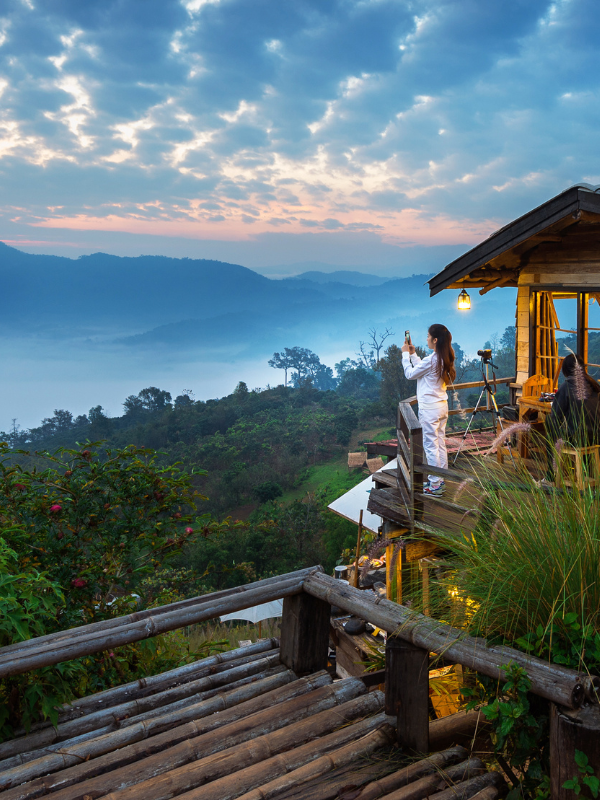

Subhasish Chakraborty
Wood Villas – Mountain Retreat with a Difference
By Subhasish Chakraborty, Kolkata
“The best things in life are the people we love, the places we have been, and the memories we make along the way.” If that be so, the North Indian state of Uttarakhand, popularly referred to as Devbhumi (or, the abode of Gods), is indeed at the forefront, positioning itself as New India’s ultimate ‘wellness tourism’ hotspot.
It is due to sustained government campaigns like ‘Atmanirbhar Bharat’, ‘National Initiative for Transforming India’ and ‘Make in India’ that smaller states like Uttarakhand are able to carve a niche for themselves and create a positive impact on the minds of global investors. The snowy peaks, picturesque settings and ancient cultural traditions of Devbhumi have been luring travellers galore for centuries. And this speck of paradise is not just confined to Rishikesh, Nainital, Mussoorie, or the iconic Jim Corbett National Park. In fact, the state government has prioritised the accelerated development of new tourist destinations such as Binsar, Brahmatal Lake, Chamba, Chopta, Dhanaulti and Dodital, to name just a few.
From the Alps to the Himalayas
Given the stunning vistas that dominate Uttarakhand, the state’s government is focussed on developing the concept of Homestays as well as Chalets/Log Huts in the higher reaches of the Himalayas, in Almora, Ranikhet and beyond.
In fact, Uttarakhand has been on the radar of hoteliers for some time now, and with a proactive administration offering incentives to investors, there has never been a better time to put money in the state’s growing hospitality sector. Moreover, the government’s focus on promoting ‘Homestay Tourism’ in the High Himalayas is having a positive effect on the villages of Uttarakhand, helping curb the temptation among locals to migrate to urban areas, and generating enough revenue for villagers who have opted to transform their homes into homestays. The concept of building villas using wood as the primary material is a new trend. Although wooden villas are commonplace in the US, Canada and most of Europe, they aren’t so familiar in India, due largely to the climatic conditions (tropical), prohibitive forestry laws, and outdated sawmills—despite the maharajas of yore patronising wood-based craftsmanship, a rich tradition that goes back centuries.
But it is to the credit of the authorities in Uttarakhand that they have been able to build luxury wooden chalets and villas in a phased manner, and at such altitudes. Indeed, the new breed of ecologically-conscious real-estate developer is the real game-changer. By combining time-honoured craftsmanship with contemporary innovations—and thereby delivering properties that are not just robust but also stunning to look at from the outside—these developers are ensuring long-term prosperity for the state.
Take, for example, the lesser known yet gorgeous Himalayan hamlet of Dhamas, 32km from Almora, a visit to which could be an eye opener. Out here, at an elevation of 1,424m (4,672ft), a silent revolution is on, courtesy the untiring efforts of a native Koranga family, whose forefathers had left behind landed properties in some of the most vantage positions.
Putting Uttarakhand on the world's map
Chandan Koranga, a fiercely proud ‘Millennial’ Kumaoni, has rather resolutely been implementing his dream project, ‘Wood Villas’, which is nearing completion. This prestigious, pioneering and one-of-a-kind project—made out of the finest variety of English wood and German pine—is an architectural marvel in the making that will take tourism in Uttarakhand to new heights, literally.Having weathered the rough-and-tumble of new-age entrepreneurship, this never-say-die Kumaoni is highly optimistic that ‘Wood Villas’ will carve a niche for itself as the most preferred chalet/villa accommodation in the state. These units, Chandan assures, will offer breathtaking views of the full range of Himalayan peaks. “The architectural finesse is every bit European and each independent villa is wholly constructed out of wood—a rarity in the Indian context!” he told us, adding, “Our client base is NRIs and high-net-worth (HNI) individuals who have shown tremendous interest in this unique project. And these villas are available for leases for up to three years, and further renewable.”
No wonder there is an air of expectancy in Uttarakhand. The changing mindset of the people here finds reflection in folks like Chandan Koranga, who are working hard to position Uttarakhand as India’s next big tourism destination. In fact, Chief Minister Pushkar Singh Dhami has gone a step further and coined the tagline, ‘Peace of Doing Business’ rather than the oft-quoted ‘Ease of Doing Business,’ while addressing an august gathering of industrialists in the UK.
Thanks to the state government’s unwavering support for Chandan and his ilk, Uttarakhand’s hilltops are on the verge of showcasing the beauty of the Himalayas in all its grandeur—through Wood Villas and Chalets. Besides offering an aesthetic charm that is timeless, these mountain homes radiate harmony and are remarkably sustainable. In fact, occupants of wooden houses have a lower carbon footprint than those of non-wooden dwellings. So, here’s hoping that tourism in Uttarakhand will stand out as a beacon in India’s pursuit of becoming a ‘net zero’ country.